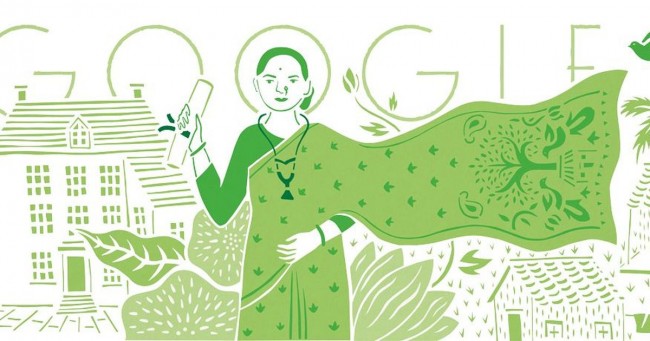Mumbai, March 31 (IANS) Google on Saturday created a special Doodle to mark the 153rd birth anniversary of Thane-born Anandi Gopal Joshi, regarded as India’s first US-trained female medico.
The Goodle, designed by Kashmira Sarode of Bengaluru, depicts a young sari-clad Anandi, with a heavy Maharashtrian nose-ring and a prominent bindi.
She is seen in the Doodle holding aloft her medical degree, sporting a stethoscope. The pallu (veil) of her sari is aflutter in the breeze as if in cheerful celebrations of her medical achievement, all at the age of 19.
In the background is the stark ground-plus-two-storied building of her alma-mater in Pennsylvania and her purported humble abode in coastal Maharashtra with typical cottages and a swaying coconut tree.
Originally named ‘Yamuna’, she was born on March 31, 1865 in Kalyan town in today’s Thane district, around 50 kms north of Mumbai. She was married off aged nine to a widower, Gopalrao Joshi, who worked as a postal clerk.
Joshi’s work later took the couple to Alibag in Raigad and then to Calcutta, now Kolkata.
At 14, Anandi gave birth to a son, but the child survived only 10 days as the necessary health care facilities were not available then.
This sparked the flame in Anandi to take up medical studies to which her husband Joshi not only agreed, but also encouraged as he was always a strong proponent of women’s education, something rare in that era.
In 1880, he wrote to an American missionery, Royal Wilder, about Anandi’s desire to pursue medicine in the US and also about prospects for himself.
Wilder published the letter in a journal after which a woman named Theodicia Carpenter of New Jersey read it and offered Anandi accommodation in the US.
However, back home in Calutta, Anandi’s health started deteriorating and Carpenter sent medicines from the US. Unfortunately, the medicines failed to heal her completely.
Finally, in 1883, Joshi decided to send his young wife alone to the US for her medical studies despite her poor health condition, and urged her to inspire other women to higher studies by setting an example.
Accordingly, she was advised to apply to the Women’s Medical College of Pennsylvania (now known as Drexel University College of Medicine), the world’s only second medical school exclusively for women launched in 1850.
However, on learning of her academic plans, the staunch Hindu conservative society of that time took strong objections. But far from getting discouraged, she met the challenge head on by addressing the community at Serampore College, India’s second oldest college.
The 17-year old Anandi forcefully defended her plans to travel to the US for a medical degree, how she and her husband had been subject to discrimination because of her moves, why the country needed Hindu female doctors and her future dream of opening a medical college for women in India itself.
Her speech was publicised widely in the media, donations poured in and she finally embarked on a ship from Kolkata to New York to reach her host, Carpenter in June 1883.
Barley 18, she secured admission to the WMCP and was enrolled by Rachel Bodley, the Dean of the august institution.
Anandi encountered fresh travails due to the harsh cold weather there, the eating habits and other problems culminating in tuberculosis, then considered a deadly disease and a huge social stigma.
However, she managed to successfully complete her medical course and was honoured with an MD degree on March 11, 1886 for her thesis “Obstetrics Among The Aryan Hindus.”
Her graduation was acknowledged by none other than the Empress of India, Queen Victoria who sent her a congratulation message.
It was time to head home and hardly 20, Anandi returned in late 1886, to a rousing reception in India, and the then state of Kolhapur appointed her as Physician-in-Charge of the female ward in the city’s Albert Edward Hospital.
However, the gnawing TB finally claimed her life on February 26, 1887. She passed away five weeks before her 22nd birthday.
Her death came as a shock and was mourned all over India. Her ashes were sent to her hostess Carpenter to be kept in her family cemetery in Poughkeepsie, New York.
The next year, US feminist author Caroline Wells Healey Dall penned Joshi’s biography. India’s Doordarshan created a Hindi serial on her life called “Anandi Gopal”, while Marathi writer Shrikrishna J. Joshi wrote a story on her life which was later adapted into a theatre production by R. G. Joglekar.
Another Marathi author Anjalai Kirtani came out with a book, “Dr. Anandibai Joshi – Kaal Ani Kartutva”, that included some extremely rare photographers of the legendary medico.
In her honour, the Institute for Research & Documentation in Social Sciences, Lucknow instituted the annual “Anandibai Joshi Award” and the Maharashtra government offers a fellowship named after her.
Though Anandi could not fulfill her dream of setting up a women’s medical college in India due to her untimely death, she inspired millions of other women in the country who took to the medical profession in a big way in the past one and half century.






